...with fresh eyes, seeking "keepers"
The end of winter is the best time of year to go look at
landscapes. Plants are down and out so you can see the garden's
bones. What's there that's pleasing is a real gem.
If you like it in March, it's a
keeper.
Build on it!
- Janet -
Open your designer's eyes and take a walk with Janet.
Color draws us out. Rich red winter color of dwarf Oregon grape
holly (Mahonia aquifolium 'Compactum'). Some winters it
goes brown but we risk that to see this. It looks great against a
healthy yew's dark green.
The brown at its feet is forgiven; it's the straw from
groundcover plumbago (Ceratostigma plumbaginoides) which
covers over the spring bulbs in this bed, then blooms blue in
August.
Pine with a dancer's grace
We're suckers for an open grown red pine (Pinus
densiflora). Such grace, and with the luminous light green
that makes the 5-needled pines so pleasing in the dark months. The
bark is gorgeous, too.
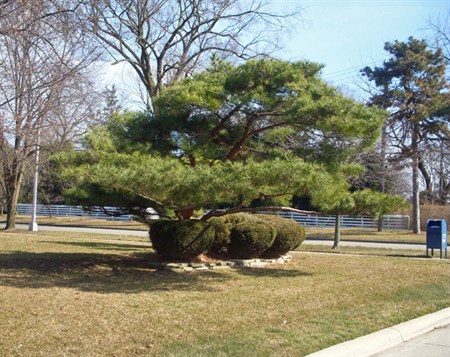
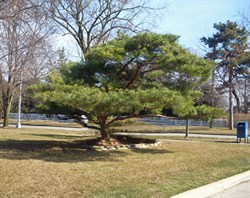
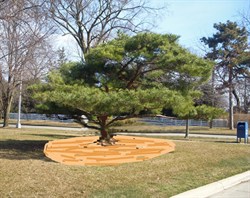
We sure wish both the bark and the tree's fluid line was more
visible!
Better walk on -- if we stand here and look long enough we're
going to start talking about pulling on dark clothing to come back
by night and chop those sheared shrubs right out of the picture.
Maybe make a big bed of salmony-orange leaf sedum under the tree to
celebrate its bark...
Walk on!
Some March finds take more work to identify
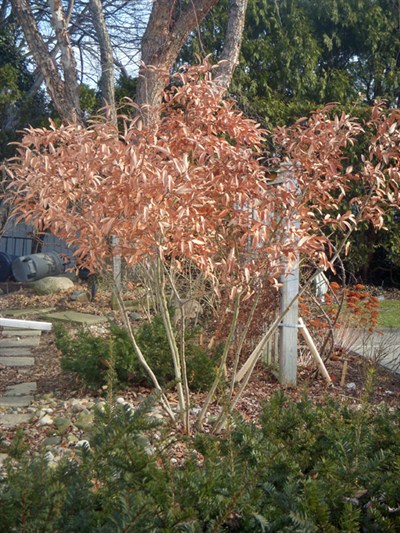
Chinese spicebush (Lindera angustifolia). Truly a four
season plant. In sun or shade it brings to a landscape early spring
bloom (yellow), versatility (grow it as a large shrub, or prune it
as we have here to let it grow as a 12' "tree"), fragrant berries
plus evergreen foliage that turns a spectacular orange in fall
before fading to salmon and hanging on until spring.
Never heard of it? It's fairly new to the North American
landscape. However, if you ask for it so garden centers will start
to take note, they'll find it for you.
To find a source for this and other plants
plantinfo.umn.edu, Minnesota Landscape
Arboretum's plant-grower data base is a great way to find sources,
for a single plant or to buy wholesale. Going to ask at your garden
center for unusual plants? Take along wholesale grower information
and leave it with the nursery manager to increase your chances.
Another big reason to support local garden centers and
growers!
We cannot have islands of excellence in a sea of slovenly
indifference.
- John W. Gardener -
Biggest coup: A commoner shining gold
One of the biggest benefits of walking and looking in March is
that you may find reason to appreciate ho-hum ordinary plants
making extraordinary contributions.
As an example, there's this oh so common plant, showing patches
of gold.
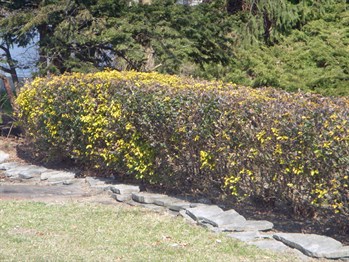
Truly ordinary. So very common...
Excellence is doing ordinary things extraordinarily well.
- John W. Gardner -

You recognize it now, right? Golden vicary privet (Ligustrum
x vicaryii) that can make use of its evergreen parentage
during a mild winter. How nice to feel a bit of respect for a plant
so ordinary we look right past it, most days.
Spark in the eye is not always a plant
Now there's a different landscape.
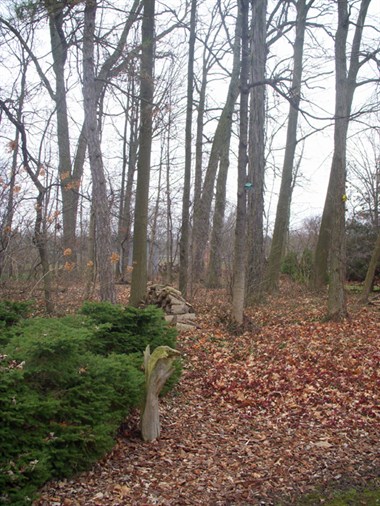
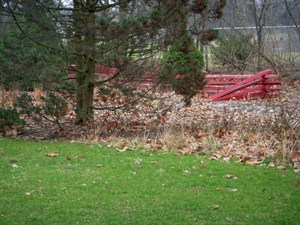
It's probably true that the view into a woods is beautiful every
day of the year. Yet what a delight to catch one flash of red and
be drawn out to find a whimsy playing a solid citizen role.
Do you see the red that caught our eye, in person, in the left
side photo?? Cameras can really see with the myriad focus we do, or
zero in so fervently on a single color or motion.
Wishing gardeners would think more often about building a
garden or landscape around such non-plant features, we walk
on.
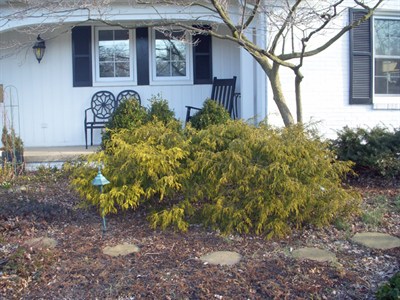
Treasure in our own front yards
Back 'round the block to the starting point, we see sun
beginning to light the dwarf gold falsecypresses (Chamaecyparis
pisifera 'Mops').
Perhaps it's the sun, exercise, air, or our deliberate attempt
to take a fresh look, but it's like light bulbs have come on. We
see this plant can answer a "something needed here" problem (more
in Upgrade to deep foundation).
At the same moment we realize that it's a good start on the example
that can answer M.R.'s evergreen pruning
question.